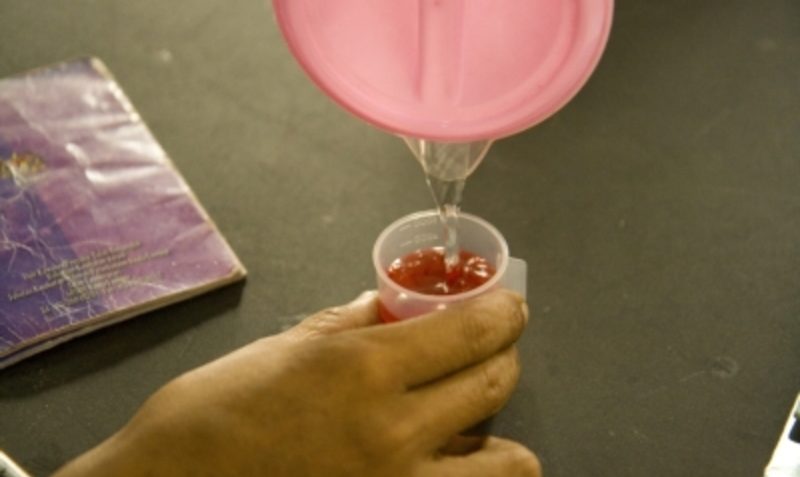Putting people at the centre of harm reduction: lessons from India
 © Frontline AIDS
© Frontline AIDS
Influence Support Officer Clare Morrison on a New Delhi clinic that puts people who use drugs at the centre of its harm reduction services.
By Clare Morrison, influence support officer
Blink, and you would miss the National Drug Dependency Treatment Centre (NDDTC) in Sunder Nagri, New Delhi. Housed in a nondescript community centre in an area known for high levels of poverty, unemployment, and conservative values, it’s not necessarily where you would expect to find a drug treatment centre.
As we walk into the clinic, a row of people wait patiently to be seen. A man in his twenties approaches the nurses’ station, ready to take his daily dose of methadone. After five minutes, the procedure is complete. His paperwork is checked and he’s free to go about his day.
I’m at the centre with HIV activists from Uganda, Zimbabwe, Ukraine, Kenya and Indonesia. We’re there as part of an HIV prevention workshop hosted by India HIV/AIDS Alliance, which brought together advocates and prevention experts from Alliance Linking Organisations to share best practice on community-led HIV programmes that put people at the centre.
Community based
NDDTC was previously housed at the district hospital but relocated to Sunder Nagri in order to reach more people and seems to have settled into the neighbourhood well. As we take a tour I’m struck by how welcoming the atmosphere is. Security is minimal; there’s no thick metal door; just a couple of locked cabinets and a solitary security guard. The staff members are friendly, with a non-discriminatory approach that seems to put people at ease.
“Integrating the clinic within the local community has been hugely beneficial,” explains Dr Roshan Bahd, one of the clinic’s doctors. “The impact of our decision to move here has been significant, not only in terms of increasing the number of people accessing services, but in reducing the stigma attached to drug use.”
Person centred
Supported by the National AIDS Council and Ministry of Health, the centre takes pride in its holistic, person-centred approach. While it regularly sees over 1,000 clients – all of whom live or work in the local area – it attempts to provide services that are tailored to meet the needs of the individual.
Each new client is screened by a doctor trained in harm reduction, who assesses their suitability for treatment. Once accepted, they are then provided with a range of treatment options, including opiate substitution therapy (OST). Here, clients are given the choice between methadone and buprenorphine, which they can access free of charge, from a specialist nurse, at a time that suits them best. This reduces unsafe injecting practices, and with it HIV transmission.
The centre also works in partnership with other local NGOs to ensure people can access other services including needle and syringe exchanges, counselling and HIV testing. NDDTC also recruit peer-educators to follow-up with clients after they are referred, and is in the process of piloting a mobile service to deliver OST directly to people in the community, providing services where they’re needed most.
Changing lives
The clinic has already had a dramatic impact on people’s lives, improving their awareness of HIV and reducing the likelihood they will engage in risky behaviour such as sharing needles, which leaves them vulnerable to HIV. But most importantly the centre helps people take back control of their lives. Once on treatment, people find it easier to hold down jobs and participate in family life. This, according to Doctor Roshan, is the best way to measure the centre’s success.
Yet the centre is not without its challenges. For all its hard work, the clinic still struggles to work with other, more marginalised groups such as adolescents and men who have sex with men. Women do occasionally approach the centre, but significant barriers remain.
At present, female drug users account for one in every 100 clients. While the centre is integrated into the local community, the majority of those living in the area are Muslim, and for the most part, women are expected to stay in their family homes and conform to traditional gender roles and stereotypes. As a result, high levels of shame and stigma prevent women from reaching out and accessing services. Employing peer outreach workers has been trialled as a possible solution, but recruiting and training female staff has proven difficult.
The centre is acutely aware these structural barriers exist, and actively works to address them. It regularly hosts workshops in schools and colleges to provide information to students and teachers on the risks associated with drug use. The centre also works with law enforcement officials, community leaders and politicians to raise awareness about harm reduction.
Reforming drug policies
Staff from NDDTC also work on capacity building and research in collaboration with India HIV/AIDS Alliance. Both organisations are part of a technical review group that provides guidance and advice to India’s National AIDS Programme on Harm Reduction. In 2014, they made recommendations to the Indian government during the revision of the Prevention of Illicit Traffic in Narcotic Drugs and Psychotropic Substances Act. These recommendations helped to legitimise OST and other harm reduction services and led to the legal recognition of methadone as an essential drug.
Although not a magic bullet, such legislation is a step in the right direction. Creating an environment where treatment centres such as this one can exist means people who might otherwise fall through the cracks can get effective support – and fewer people will become HIV positive as a result.
You can read more about the Alliance’s work in India here.
This article was written as the International HIV/AIDS Alliance, before we changed our name to Frontline AIDS.
Tags
Harm reductionIndia


